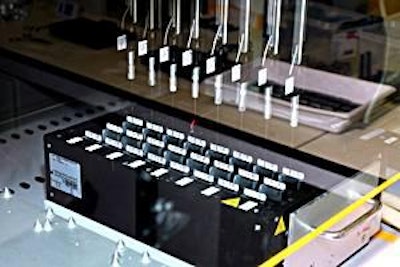
Below is a listing of 12 of the most modern terms used in SNP genotyping and genomic selection every pig producer needs to know. The following terms and definitions are courtesy of Topigs.
Gene mapping : Determination of the relative positions of genes on a DNA molecule (chromosome or plasmid) and of the distance, in linkage units or physical units, between them. A gene or other identifiable portion of DNA whose inheritance can be followed.
Genome : All the genetic material in the chromosomes of a particular organism; its size is generally given as its total number of base pairs.
Genomics : The study of genes and their function.
Genomic Selection : The simultaneous use of thousands of DNA markers to estimate the breeding value of an individual.
GWAS : Genome-wide association study (GWA study, or GWAS), also known as whole genome association study is an examination of all or most of the genes (the genome) of different individuals of an articular species to see how much the genes vary from individual to individual. Different variations are then associated with different traits, such as diseases.
Imputation : Genotype imputation an essential tool in the analysis of genome-wide association scans. This technique allows geneticists to accurately evaluate the evidence for association at genetic markers that are not directly genotyped.
Marker assisted selection or marker aided selection (MAS) : The process whereby a marker (morphological, biochemical or one based on DNA/RNA variation) is used for indirect selection of a genetic determinant or determinants of a trait of interest (i.e. productivity, disease resistance, abiotic stress tolerance, and/or quality). In our case, SNPs are the markers.
QTL Quantitative trait loci : QTLs are stretches of DNA containing or linked to the genes that underlie a quantitative trait. Mapping regions of the genome that contain genes involved in specifying a quantitative trait is done using molecular tags or, more commonly SNPs . This is an early step in identifying and sequencing the actual genes underlying trait
variation.
QTL Mapping : The statistical study of the alleles that occur at a locus and the phenotypes (physical forms or traits) that they produce. Because most traits of interest are governed by more than one gene, defining and studying the entire locus of genes related to a trait gives hope of understanding what effect the genotype of an individual might have in the real world.
Sequencing : The determination of the order of nucleotides (base sequences) in a DNA or RNA molecule or the order of amino acids in a protein. Single nucleotide polymorphism (SNP) DNA sequence variations that occur when a single nucleotide (A, T, C, or G) in the genome sequence is altered.
Single nucleotide polymorphism (SNP) : DNA sequence variations that occur when a single nucleotide (A, T, C, or G) in the genome sequence is altered.
SNP genotyping : The measurement of genetic variations of single nucleotide polymorphisms (SNPs) between members of a species. It is a form of genotyping, the measurement of the genetic variation more generally. SNPs are one of the most common types of genetic variation. An SNP is a single base pair mutation at a specific locus, usually consisting of two alleles.

















